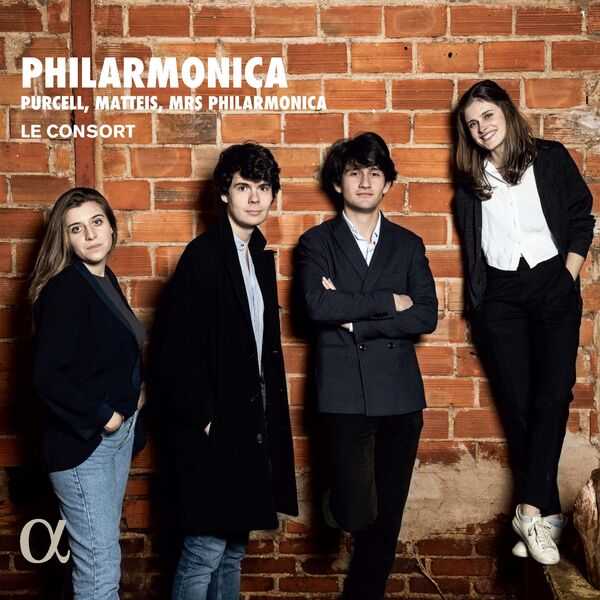

Composer: Nicola Matteis, Mrs Philarmonica, Henry Purcell
Performer: Le Consort
Format: FLAC (tracks)
Label: Alpha
Catalogue: ALPHA1011
Release: 2023
Size: 2.44 GB
Recovery: +3%
Scan: yes
01. Matteis the Elder: Suite in G minor: Andamento malinconico
02. Purcell: Trio Sonata in G Minor, Z807 (from Ten Sonatas in Four Parts)
Mrs Philarmonica: Sonata terza in G minor, Parte Prima
03. I. Largo
04. II. Vivace
05. III. Lento
06. IV. Tempo giusto
Matteis the Elder: Suite in C minor
07. I. Préludio in C solfaut
08. II. Andamento
09. III. Borre
10. Purcell: Trumpet Tune in C major, ZT 698, from the Indian Queen
Mrs Philarmonica: Sonata sesta in G major
11. I. Largo e Staccato
12. II. Con Spirito ma non presto
13. III. Lento
14. IV. Vivace
15. Matteis the Elder: Diverse Bizzarie Sopra La Vecchia Sarabanda O Pur Ciaconna
Mrs Philarmonica: Sonata quinta in C minor
16. I. Andante e con Spirito
17. II. Largo
18. III. Allegro
19. Purcell: Queen’s Dolour in A minor, Z670
Matteis the Elder: Suite in A minor
20. I. Sarabanda amorosa
21. II. Adagio
22. III. Gavotta
23. IV. Scaramuccia
Mrs Philarmonica: Sonata quarta in B minor, Parte Prima
24 .I. Largo Andante
25. II. Allegro
26. III. Adagio
27. IV. Vivace
Matteis the Elder: Suite in G minor
28. I. Adagio
29. II. Corrente
30. III. Untitled & Division
31. IV. Fancy called hold the Tongue
32. Purcell: Two in One upon a Ground
33. Matteis the Elder: Maniera italiana
In the second half of the seventeenth century, London experienced an artistic golden age, with the arrival of many foreign musicians and the proliferation of theatres and concert halls where audiences came to listen to the stars of the moment. One of these musicians was the Italian Nicola Matteis, who arrived around 1660 and became the sensation of the London music scene. Purcell was only a child at the time and there is no record of their meeting, but it is very likely that he was familiar with Matteis’s works, including his Ayres, recorded here for the first time in a version for four-part consort. Exploration of this London effervescence yields to some surprising discoveries, such as the music of a mysterious composer who published trio sonatas around 1715 under the name Mrs Philarmonica. Le Consort presents the very first recording of this highly interesting music, probably influenced by Corelli and very likely written by a woman composer who, given the conventions of the time, made use of a pseudonym. Her true identity is unfortunately unknown to us.
This release from the historical performance group Le Consort (two violins, cello, and continuo) has several attractive features from the repertory point of view. Le Consort offers three generations of English instrumental music, dating from the Italian import Nicola Matteis through Henry Purcell to the composer called Mrs Philarmonica, active around 1725. She is described in the booklet accurately as a mystery; no one has yet established her identity (or even if she is indeed female, although one assumes she is). She is represented by four trio sonatas (called simply “sonata”) that are in a Vivaldian style and are thoroughly enjoyable; recordings of her work are not common, and this zippy one is welcome. Sample the second movement of the Sonata sesta in G major, marked Con spirito ma non presto. The performance here might indeed be presto, but it is very exciting. Equally interesting are the works by Nicola Matteis, who introduced the Italian style to England and diverted English music from a slavish imitation of French models. His works here are offbeat and often fiery. Sample the “Scaramuccia” finale from the Suite in A minor or the finale of the Suite in G minor with the title Fancy called hold the Tongue. The Purcell pieces are mostly better-known melodies arranged for the small group here, certainly something in keeping with practices of the time, and they provide a few “hits” interspersed among the unfamiliar material. The only real complaint here is the sound from the Christuskirche in Paris; it is noisy and really overdone in music that can speak for itself, and that never sounded like this in the chambers for which it was composed. However, anyone who has ever wondered about Mrs Philarmonica should pick up a copy of this album.



